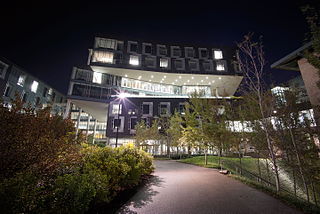
The School of Computer Science (SCS) at Carnegie Mellon University in Pittsburgh, Pennsylvania, US is a school for computer science established in 1988. It has been consistently ranked among the top computer science programs over the decades. As of 2022 U.S. News & World Report ranks the graduate program as tied for second with Stanford University and University of California, Berkeley. It is ranked second in the United States on Computer Science Open Rankings, which combines scores from multiple independent rankings.
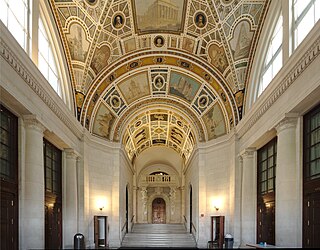
The College of Fine Arts (CFA) at Carnegie Mellon University in Pittsburgh, in the U.S. state of Pennsylvania oversees the Schools of Architecture, Art, Design, Drama, and Music along with its associated centers, studios, and galleries.

The architecture of Atlanta is marked by a confluence of classical, modernist, post-modernist, and contemporary architectural styles. Due to the Battle of Atlanta and the subsequent fire in 1864, the city's architecture retains almost no traces of its Antebellum past. Instead, Atlanta's status as a largely post-modern American city is reflected in its architecture, as the city has often been the earliest, if not the first, to showcase new architectural concepts. However, Atlanta's embrace of modernism has translated into an ambivalence toward architectural preservation, resulting in the destruction of architectural masterpieces, including the Commercial-style Equitable Building, the Beaux-Arts style Terminal Station, and the Classical Carnegie Library. The city's cultural icon, the Neo-Moorish Fox Theatre, would have met the same fate had it not been for a grassroots effort to save it in the mid-1970s.
Roger Duffy is an American architect, known for rigorous and unconventional approach to design. Now retired, he worked as a partner at the firm Skidmore, Owings & Merrill. He was a design partner in the New York office from 1995 until 2018, and is a member of the American Institute of Architects and the League Circle of the Architectural League of New York.
Preston Scott Cohen is a professor of Harvard Graduate School of Design (GSD). In 2004, he established a partnership with two registered architects, Amit Nemlich and Gilles Quintal, and became the Design Principal of Preston Scott Cohen, Inc. based in Central Square Cambridge, Massachusetts. Preston Scott Cohen, Inc. is renowned for the design of cultural, educational, commercial buildings and urban design projects around the world. Projects include the Sarmiento Performing Arts Center in Bogota, Colombia; a new building for Taubman College at the University of Michigan; the Taiyuan Museum of Art in Taiyuan, China; the Datong City Library; the Amir Building, Tel Aviv Museum of Art; and the Goldman Sachs Canopy in New York. The firm is also well known for non-profit projects including the Cape Rep Theater, Temple Beth El in Springfield, MA, and the Detroit Chabad. Cohen has received numerous honors including induction as an academician at the National Academy of Art, five Progressive Architecture Awards, first prizes for seven international competitions and an Academy Award from the American Academy of Arts and Letters. Cohen is the author of Lightfall, The Return of Nature (2015), Contested Symmetries (2001), and numerous theoretical essays on architecture. His work has been widely exhibited and is held in numerous museum collections.
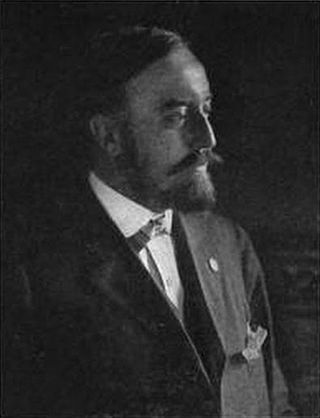
Henry Hornbostel was an American architect and educator. Hornbostel designed more than 225 buildings, bridges, and monuments in the United States. Twenty-two of his designs are listed on the National Register of Historic Places, including the Oakland City Hall in Oakland, California and the Soldiers and Sailors Memorial Hall and Museum and University Club in Pittsburgh, Pennsylvania.
The College of Design at the Georgia Institute of Technology, established in 1908 as the Department of Architecture and also formerly called the College of Architecture, offered the first four-year course of study in architecture in the Southern United States.

Texas Tech University College of Architecture is the college of architecture at Texas Tech University in Lubbock, Texas. The architecture program has existed at Texas Tech University since 1927. Texas Tech's Master of Architecture is a professional degree and it is accredited by the National Architectural Accrediting Board (NAAB). On November 30, 2022, the school announced it would be named the Huckabee College of Architecture.
William Augustus Edwards, also known as William A. Edwards was an Atlanta-based American architect renowned for the educational buildings, courthouses and other public and private buildings that he designed in Florida, Georgia and his native South Carolina. More than 25 of his works have been listed on the National Register of Historic Places.

Beyer Blinder Belle Architects & Planners LLP (BBB) is an international architecture firm. It is based in New York City and has an additional office in Washington, DC. The firm's name is derived from the three founding partners: John H. Beyer, Richard Blinder, and John Belle. The three architects met in 1961 while working in the New York office of Victor Gruen. The trio developed a specialty in historic preservation.

SMBH, Inc. is a full-service structural engineering firm located in Columbus, Ohio. Providing structural engineering services for architects, contractors and building owners, SMBH, Inc. has experience designing educational facilities, medical centers, courthouses and commercial and residential buildings. Since 1972, SMBH, Inc. has served the architectural and construction communities in Ohio and surrounding states. SMBH, Inc. has worked with architectural firms such as Graham Gund's Gund Partnership, Mack Scogin Merrill Elam Architects, Peter Eisenman, and Robert A.M. Stern.
Austin Eldon Knowlton was a trained architect who spent most of his career in the construction industry. His company designed, financed, and built more than 160 college and university buildings on every major college campus in Ohio and more than 200 elementary and secondary school buildings. His companies have also constructed more than 35 major hospitals and 43 United States Post Offices throughout the country. In his lifetime, he designed more than 600 buildings.
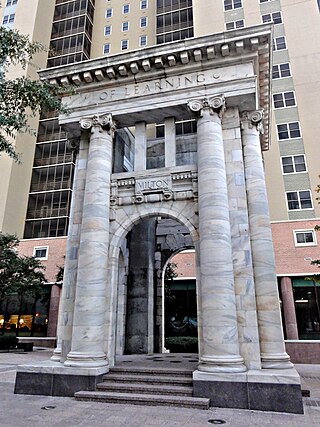
The Carnegie Education Pavilion, more often known as the Carnegie Monument, is a marble Beaux-Arts monument located in Atlanta, Georgia, United States. The pavilion was constructed in 1996 from the exterior facade of the Carnegie Library, named after Andrew Carnegie. The monument pays homage to the legacy of Carnegie by serving as a monument to higher education in Atlanta, with the seals of nine local area colleges and universities embedded in the floor of the monument. The monument was commissioned in 1996 by the Corporation for Olympic Development in Atlanta and designed by Henri Jova. The pavilion is located in Downtown's Hardy Ivy Park, at the curve in Peachtree Street where it diverges with West Peachtree Street. The monument's inscription reads: "The Advancement of Learning." It also features the inscriptions of the names of three famous Western poets "Dante", "Milton", and "Asop", in addition to the library's namesake, "Carnegie".
Geoffrey Lloyd Preacher was an American architect. Based in Atlanta, Preacher and his firm specialized mostly in commercial offices, hotels, and apartment buildings in the Southeastern United States.
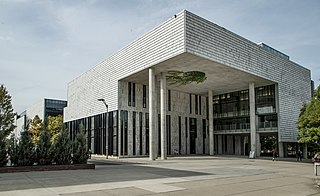
Knowlton Hall, located in Columbus, Ohio, United States, is the current home for the three disciplines that comprise the Austin E. Knowlton School of Architecture (KSA) at The Ohio State University. The building was completed in 2004. The School of Architecture offers both undergraduate and graduate degrees in the fields of Architecture, Landscape Architecture, and City and Regional Planning. Knowlton Hall serves as the replacement for Ives Hall, the previous home of the school of architecture which was demolished in July 2002. The namesake of Knowlton Hall is Austin E. "Dutch" Knowlton. He graduated from The Ohio State University in 1931 with a Bachelor's in Architectural Engineering and provided a $10 million donation that spearheaded the funding for the creation of the building.
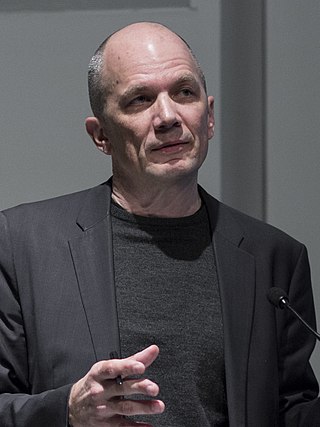
Michael Maltzan is the principal architect at Michael Maltzan Architecture (MMA), a Los Angeles–based architecture firm. He received a Master of Architecture degree from Harvard University and both a Bachelor of Architecture degree and a Bachelor of Fine Arts degree from the Rhode Island School of Design. Maltzan was selected as a Fellow of the American Institute of Architects in 2007.
Merrill Elam is an American architect and educator based in Atlanta, Georgia. She is a principal with Mack Scogin in Mack Scogin Merrill Elam Architects where their work spans between buildings, interiors, planning, graphics and exhibition design, and research.

The architecture of Jacksonville is a combination of historic and modern styles reflecting the city's early position as a regional center of business. According to the National Trust for Historic Preservation, there are more buildings built before 1967 in Jacksonville than any other city in Florida, though few structures in the city center predate the Great Fire of 1901. Numerous buildings in the city have held state height records, dating as far back as 1902, and last holding a record in 1981.

The Austin United States Courthouse is a federal courthouse in downtown Austin, Texas. Built between 2009 and 2012, the building houses the Austin division of the United States District Court for the Western District of Texas and other federal judicial offices. It replaced the 1936 Austin U.S. Courthouse, which has since been transferred to Travis County to hold county judicial space.

The Carnegie Building is a historic building located at 141 Carnegie Way in downtown Atlanta, Georgia, United States. Built in 1925 as the Wynne-Claughton Building, the 12-story building was designed by architect G. Lloyd Preacher. It was designated an Atlanta Historic Building in 1990 and was added to the National Register of Historic Places in 2012.












